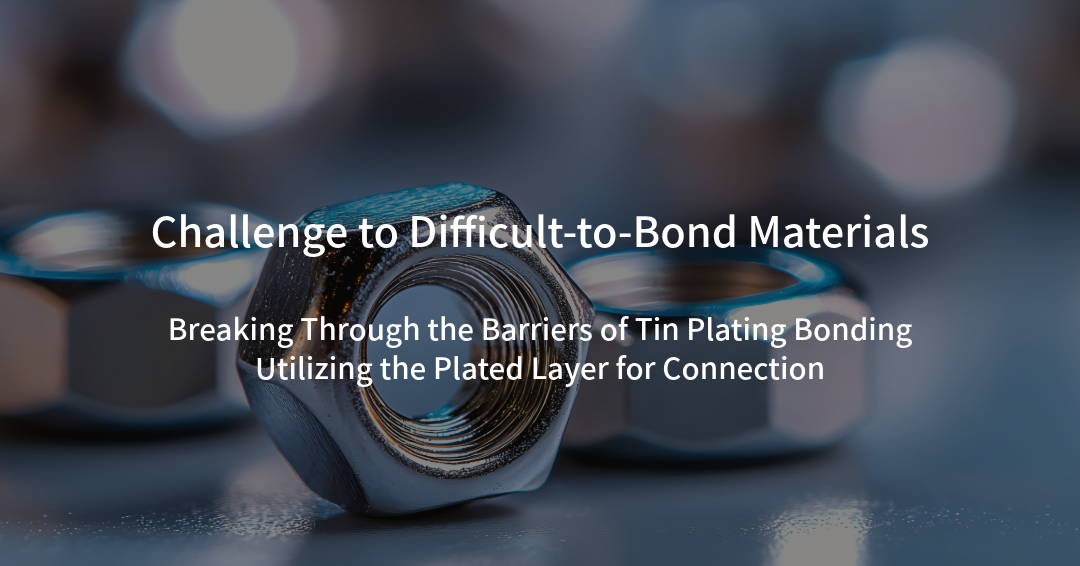Tin (Sn) plating is widely used in electronic components, battery terminals, and connectors. It's affordable and boasts excellent solderability, conductivity, corrosion resistance, lubrication, and chemical resistance. For instance, in the classic design of male threaded external terminals for secondary batteries, the soft, lubricious tin plating was leveraged: tightening the female thread would intentionally scrape off the tin, allowing the base metals to contact and ensure electrical conduction while preventing rust.
However, threaded fastening is being replaced by direct bonding terminal structures due to issues like high cost, increased weight, and complex tightening management. Suddenly, the protective tin plating became an obstacle. When welded, tin's low boiling point causes internal defects (voids) and spatter, leading to poor weld quality.
The demand arose: Can we bond these parts without removing the plating? LINK-US's Ultrasonic Complex Vibration Bonding (UCVB) technology answers this need.
You might ask, "Can't regular ultrasonic bonding handle this?" Not easily. The excellent lubrication properties of tin plating make it a tricky adversary. Let us explain.
table of contents
The Challenge of Tin Plated Material Bonding
The inherent paradox of tin plating is its detriment to welding quality:
- Intermetallic Compound (IMC) Formation: Fusion welding creates IMCs between the base metal and the plating layer upon re-solidification. These compounds are brittle and possess high electrical resistance.
- Internal Defects & Spatter: The difference in boiling points between the plating and base metal easily causes internal voids and spatter, raising concerns about reduced mechanical strength due to material thinning.
- Aging Degradation: The joint is prone to degradation under thermal cycling and humid environments.
- Necessity of Plating Removal: Achieving a sound weld typically requires an extra step to remove the plating before welding.
Tin plating has always been both an ally and an enemy of reliable bonding.
LINK-US Solution: Bonding While Preserving the Plating Layer
UCVB achieves solid-state bonding with low heat input and low energy, differentiating it from conventional methods. The unique scrubbing action of the complex vibration allows for the direct bonding of the base metals without excessively damaging the tin plating layer.
This translates to:
- Direct Bonding with Plating Intact: No removal step necessary.
- No Formation of Brittle IMCs: Ensures joint stability.
- Preservation of Tin Plating Functionality: The base metal is bonded while retaining the tin layer's functions (conductivity, corrosion resistance, solderability).
- Burr and Contamination-Free: Improves yield and reduces the burden on subsequent processes.
UCVB achieves solid-state bonding that is difficult even for conventional ultrasonic techniques because its unique vibration trajectory allows it to "leverage the plating layer without over-destroying it."
Application Examples
- Battery Tabs and Terminals: Directly bonds tin-plated aluminum or copper tabs, contributing to improved battery pack performance.
- Connectors and Electronic Components: Joins tin-plated terminals and pins without pre-treatment, ensuring both electrical conductivity and corrosion resistance.
- Board Mounting: Low-heat bonding on plated pads allows for mounting heat-sensitive electronic components without thermal damage.
Effects and Benefits
- Process Reduction: Eliminates the "plating removal" step essential for welding, significantly improving production efficiency.
- Enhanced Reliability: Low heat input and reduced residual stress result in a long lifespan and stable performance under environmental fluctuations.
- Cost Reduction: Improved yield combined with reduced process steps cuts overall production costs.
- Expanded Design Freedom: Eliminates bonding issues caused by plating, increasing material and design flexibility.
Future Outlook
Tin-plated materials will continue to be widely used in EV batteries, power modules, and electronic devices. As miniaturization and high-power density increase, the demand for joint reliability intensifies, and the need for "plating-agnostic bonding" grows.
UCVB can handle not only Sn plating but also Ni and Cu layers, making it flexibly adaptable to the complex surface-treated materials of the next generation. This capability empowers new design ideas in EMS, EV, and secondary battery manufacturing processes.
Summary
While tin plating enhances component performance, it has posed a long-standing challenge to bonding. LINK-US's Ultrasonic Complex Vibration Bonding achieves strong bonding regardless of the plating layer's presence, breaking through the conventional technical barrier.
As a new standard that simultaneously achieves high-quality bonding and improved manufacturing efficiency, the value of UCVB for plated materials will surely expand across all industries.
→ For detailed technical review or to discuss a PoC concerning tin plating bonding, please contact LINK-US.

